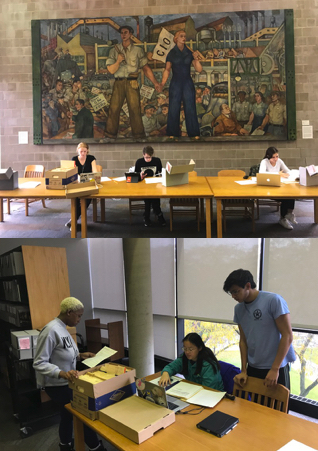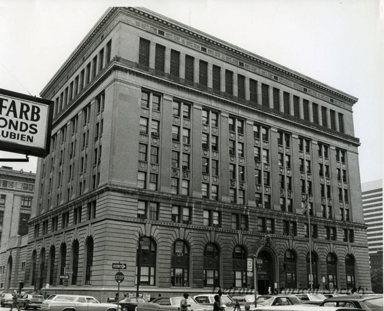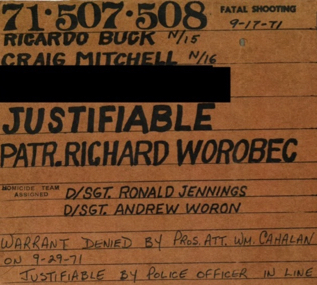Politics and Silences in the Historical Archive
All archives have political agendas and reflect the power relations of "competing groups and individuals who have unequal access to . . . the production of historical narratives," as Michel-Rolph Trouillot argued in the influential book Silencing the Past: Power and the Production of History. Archives are full of documents produced by historical actors whose perspectives and agendas always shape the form and content of the source, and they are riddled with silences and omissions of the groups and individuals whose perspectives and agendas are missing entirely or portrayed only by others with more power.
Whose stories are told or not told in the historical archives, and from whose perspective these stories are told, is therefore inevitably a question of power and access. Our project has been fortunate to have access to multiple research archives whose mission includes documenting the history of African American life and politics in the city of Detroit in addition to the history of the government agencies that shaped their experiences in the city, but these archives are still inevitably incomplete and privilege the perspectives of particular actors and groups over others. The experiences of many ordinary people never enter the historical archive at all, making a project designed to excavate police violence inevitably partial and incomplete. The internal records of the Detroit Police Department are also not public, not easily accessible except for fragments, and inherently imbalanced toward a police version of events that revolves around not just "facts" but also silences, distortions, and fabrications.
The Detroit Under Fire team conducted research in five main physical archives: the Walter P. Reuther Library/Archive of Labor and Urban Affairs at Wayne State University, the Burton Historical Collection at the Detroit Public Library, the Michigan State Archives in Lansing, the Bentley Historical Library at the University of Michigan, and the Labadie Collection of Social Protest at the University of Michigan. These archives contain relevant records of elected officials (especially Detroit mayors), government agencies, civil rights organizations, and individual activists. These records include documentation of law enforcement policies and a fair amount of correspondence from ordinary people, especially middle-class Black residents of Detroit, recounting incidents of police brutality and misconduct. In a small but vital number of cases, the archival collections contain investigative files by civil rights agencies and organizations that challenged the official police department story and documented incidents of brutality and misconduct, excessive force and wrongful death, and even criminal conspiracies to cover up murder. What they do not contain are many internal records of the police department itself, except in a few instances when an anguished family or a community protest convinced an elected official or a municipal agency to request such information.
The research team supplemented the documents found in these archives with exhaustive searches of digital newspaper databases (especially the Detroit Free Press and Detroit News) and a broad range of other digitized resources, most notably the federal civil rights files from the National Archives contained in ProQuest History Vault and law enforcement reports from the National Criminal Justice Reference Service database. The student teams also researched the Michigan Chronicle, Detroit's African American weekly, primarily on microfilm, as this indispensable resource was not digitized by ProQuest until mid-2020. The newspapers in particular contain many valuable leads but are also--as detailed below--very problematic and often misleading as historical sources about police violence. To the extent possible, our research team evaluated and contrasted the perspectives found in mainstream newspapers and government archives with the documents compiled by civil rights/black power/radical left organizations and the newsletters and public reports that these groups disseminated. Every once in a while, a mainstream newspaper would conduct its own investigation into a controversial police department killing or a particularly egregious mass violation of civil rights and civil liberties, but for the most part the Detroit Free Press and the Detroit News printed the police department's version of the "war on crime" in general and of the specific incidents when its officers shot and killed residents of the city. This reality means that a research investigation of historical patterns of police violence must not only uncover competing perspectives to the extent possible but also must interpret the state-produced stories with creativity and skepticism, looking for the patterns contained not only in the archival documents but also in their persistent, conspicuous, and revealing silences.
Documenting Police Violence: The Tip of the Iceberg
The total number of people killed by the Detroit Police Department (DPD) during the time period examined in this Detroit Under Fire exhibit is unknown and ultimately unknowable. The archival silences and distortions are deliberate and systematic. While researchers in the Policing and Social Justice HistoryLab have laboriously documented about 75% (151 of 201) of the on-duty "justifiable" police homicides acknowledged by the DPD, this official total is definitely an undercount. Even finding out the officially acknowledged total for the 1957-1973 time period was based on fortunate archival discoveries made by our research team (documents here and here), not on information publicly reported by the DPD. Scholars of state violence have estimated that the official total of police-involved homicides compiled by the U.S. federal government in recent decades only includes about half of the actual people killed by law enforcement agencies, and the problem of accurate statistical reporting becomes even greater for researchers focused on the more distant past. In addition, an unknown but not insignificant number of fatalities caused by police officers never even result in official Homicide Bureau investigations and determinations of whether the homicide was "justifiable" by the prosecutor, such as people killed but unreported by police officers in the presence of no witnesses; people beaten in custody inside police precinct stations and local jails whose deaths are recorded as accidents or suicides or 'natural causes'; people killed by police officers engaged in criminal activity (such as two drug dealers shot by an unidentified DPD officer in 1972); people shot by law enforcement during the 1967 Detroit Uprising but attributed to unknown "snipers"; people whose deaths were misclassified by coroners who worked closely with Homicide Bureau investigators, and multiple other scenarios. Some never-solved murders also raise unanswerable questions about potential police involvement, such as the elimination of witnesses scheduled to testify in the Pingree Street Conspiracy trial of corrupt narcotics officers or the killing of the executive director of the Michigan Civil Rights Commission in a downtown parking garage two blocks from DPD headquarters in 1970 as he pursued an investigation into police brutality coverups, and which the NAACP labeled a "political assassination."
Even when the identities of people killed by police officers can be determined, it is often difficult or impossible to find evidence in the historical archives that does not simply reflect the story that the police department wanted to tell. In a majority of the police homicides identified by our project during the 1957-1973 period, the only information available in the public record is a brief article or notice in the inside pages of the Detroit Free Press or Detroit News, the city's two establishment newspapers, based solely on the daily media report provided by the police department. The mainstream newspapers also often stigmatized and criminalized the people killed by law enforcement officers by headlining them in reports as "thug," "ex-convict," "parolee," "felon," "addict," and other identities provided by the police themselves. Even the Michigan Chronicle, Detroit's African American weekly, which reported in more depth on Black victims of police violence and at times challenged the official DPD account through investigative reporting, also depended heavily on the police incident report for its journalism and not infrequently portrayed poor Black males killed by police officers as "thugs." In up to one-fourth of the officially acknowledged police homicides between 1957 and 1973, our project was unable to find any information at all about who died and what happened. While some of these omissions certainly are the result of failing to search for the right combination of keywords in digitized newspaper databases, in a substantial number of cases the public record does not exist--none of the first seven Black males killed by the notorious STRESS decoy unit during 1971 even made it into the newspapers until after STRESS officers fatally shot two unarmed teenagers and massive community protests inspired the media to investigate the undercover operation's back story, revealing among other details that a single police officer had participated in eight fatal shootings, and nine others had been involved in multiple shootings, without even making the news.
When internal police records are available, they must be evaluated with extreme skepticism. Police incident reports routinely distorted and lied about the circumstances of officer homicides and other brutality incidents, and the so-called "Blue Curtain"--the internal code that prohibited police officers from exposing misconduct and even criminality by another officer, at the clear risk of career-ending retaliation--collectively covered up wrongful actions and obstructed internal and external investigations into the matter. From the top down, the Detroit Police Department during this period whitewashed almost all internal inquiries into officer misconduct and obstructed all external investigations--this is documented in every section of the Detroit Under Fire exhibit. The Homicide Bureau and the Wayne County Prosecutor, responsible for the city of Detroit, routinely found police homicides to be "justifiable" regardless of the actual circumstances. The pattern of coverup is evident in every controversial case where our project has been able to locate Homicide Bureau or prosecutorial documents in the archives of politicians and civil rights groups, and also in two--the fatal shooting of Cynthia Scott in 1963, and the fatal shooting of teenagers Ricardo Buck and Craig Mitchell in 1971--where we obtained the Homicide Bureau files through the Freedom of Information Act and conducted the substantive investigation that never happened at the time. Our project's assessment that at least 25 percent of the 188 police homicides that we identified should have been prosecuted as criminal acts of murder or manslaughter is both a conservative estimate, given that in many cases there is not enough information available to even make a determination, and a persuasive argument that the historical archives of police departments and prosecutors should be opened to the public comprehensively as with other government agencies and not subjected to the expensive, protracted, and often insurmountable obstacles of the convoluted Freedom of Information Act process.
The police brutality and misconduct incidents documented in each section of the exhibit represent only the tip of a very large iceberg in terms of what actually happened on the ground in police-civilian encounters during the 1957-1973 time period. The approximately 400 police brutality and misconduct incidents documented in the exhibit as a whole, and mapped on the "Patterns of Police Brutality" pages for each chronological section, likely do not add up to the number of police violations of civil and constitutional rights of the residents of Detroit during a typical month or probably even week. In the late 1950s and early 1960s, around one-third of all arrests made by DPD officers were illegal "investigative arrests" without any evidence--most also based on unconstitutional racial profiling--that the police department discontinued only after the city of Detroit enacted an "anti-loitering" ordinance in 1964 that gave police the discretionary authority to arrest civilians on any pretext. The Tactical Mobile Unit, just one part of the DPD, recorded more than 150,000 stop-and-searches of motorists and pedestrians per year during the late 1960s--the vast majority of them racial profiling encounters without legal cause, and yet only a subset of the recorded and unrecorded "stop-and-frisks" carried out annually by DPD officers. Many of the documented brutality incidents occurred when police officers retaliated against Black citizens who protested these unconstitutional stop-and-search operations, and yet only an extremely small percentage of the encounters themselves are recoverable in any public or even closed police archive. The small number of citizens who filed formal complaints faced significant risk of police retaliation, as the Michigan Civil Rights Commission documented in a major 1968 investigation (quoted above), meaning that most people never reported police brutality and misconduct out of either fear or a sense of futility that the internal investigation would inevitably be a coverup. The Detroit Police Department, in partnership with the Michigan State Police and the Federal Bureau of Investigation, also illegally placed hundreds of thousands of political activists under surveillance during these years. All of these files are closed to public scrutiny under a controversial privacy arrangement that only allows the person surveilled to request access and choose whether to make the police misconduct public.
Our research in physical archives and digital newspaper databases uncovered many incidents of police brutality but also illustrated the political imbalances and silences inherent in historical archives. Many of the police brutality complaints documented in the first section of the exhibit came from the NAACP Detroit Branch Records at the Reuther Library at Wayne State University. These important sources nonetheless come primarily from the middle-class Black citizens who were the most likely to report police encounters to the NAACP, meaning that historical documentation is inevitably undercounting the patterns of police brutality in poor Black neighborhoods--but even the complaints from more affluent African Americans represent only a small fraction of the total. (The NAACP records at the Reuther Library are also unfortunately missing the organization's files for much of the 1960s and most of the 1970s). The DPD's "crash" crackdown that began in December 1960 and arrested 1,500 African American males as suspects in a murder investigation left almost no archival records by those detained except for a single affidavit in the U.S. Civil Rights Commission records on ProQuest by a man who was horribly tortured by police officers--again, only the tip of an impossible to measure iceberg. The records of the Detroit Commission on Community Relations (DCCR), also at the Reuther Library, contain a number of important external investigations and documents that reveal DPD coverups of brutality and homicide incidents--but only in a small percentage of cases where family or community pressure escalated the event to the level of external scrutiny, and only through 1967 because after then the police department began refusing to share any internal investigation files with the DCCR. The increasing power of the Detroit Police Officers Association union also meant that records from most internal disciplinary proceedings were legally privileged from disclosure starting in the late 1960s, a development that almost completely obstructed the Michigan Civil Rights Commission's efforts to conduct external inquiries into DPD brutality against African American citizens. The mobilization of black power and radical left organizations in the late 1960s and early 1970s created new forms of documentation of police violence, especially in poorer Black neighborhoods, and the papers of activists such as Kenneth Cockrel and Sheila Murphy are particularly valuable resources, with the continuing cautionary note that these sources only reflect a small fraction of the total history.
The documentation of police violence, homicides, brutality, and misconduct contained in each section of this exhibit is as thorough as was possible for our collaborative project during the time frame available and is deeply indebted to the organizations, activists, and ordinary people who did their best to create a counter-archive to the dominant state version as these events unfolded. Where individual accounts are not available--meaning the vast majority of actual encounters--the exhibit provides compelling evidence of the broader law enforcement policies and patterns that shaped the experiences of daily life in the city of Detroit, particularly, but not only, for the African American community. Detroit Under Fire inevitably captures only a small part and a limited perspective of the everyday lived reality of the encounters between the residents of Detroit and their police department during the civil rights era, but the structural and systemic patterns of police violence, and the resilience and resistance of Black Detroiters in particular, are clear and undeniable even in an archive shaped by unequal power relations and pervaded by distortions and silences.
Sources
Michel-Rolph Trouillot, Silencing the Past: Power and the Production of History (1995)
Patrick Ball, "Violence in Blue," Granta Magazine (March 2016), https://granta.com/violence-in-blue/
Andrew Baer, "The Men Who Lived Underground: The Chicago Police Torture Cases and the Problem of Measuring Police Violence, 1970-2016," Journal of Urban History (2017)



